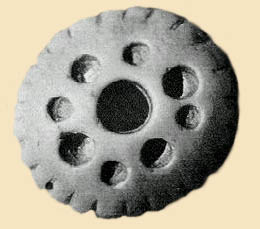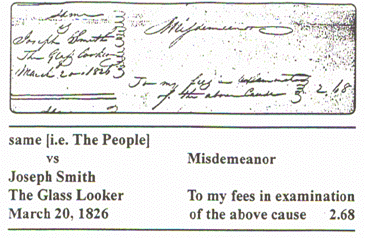
9. Joseph's Use of the Seer Stone to Find Treasure

Joseph had more than one "seer stone" during his life. In approximately 1819 Joseph borrowed a seer stone from a friend to find a "whitish" seer stone in an iron kettle 25 feet underground. The seer stone with which most students are familiar is the dark stone Joseph Smith found in 1822 while digging a well for Willard Chase (Quinn 1987, 39-41). Speaking of this stone, Joseph Capron testified that Joseph could see wondrous sights in it, "ghosts, infernal spirits, mountains of gold and silver." Joseph, his father, and some of the other men in the area, occasionally sought for buried treasure with Joseph using his seer stone in an attempt to locate the treasure.
On one occasion, Joseph impressed Josiah Stowel by describing in detail his "house and outhouses" in South Bainbridge. Stowel decided to hire Joseph and his father to help search for treasure. During the search, they stayed with Isaac Hale, the father of Joseph's future wife Emma. In the beginning, Hale helped subsidize Stowel's expeditions into the mountains, but after the first failures he was quickly disillusioned and became contemptuous of Joseph's efforts. Nine years later he wrote of Joseph, who by then had become his son-in-law:
"His appearance at this time, was that of a careless young man - not very well educated, and very saucy and insolent to his father . . . Young Smith gave the 'money-diggers' great encouragement, at first, but when they arrived in digging to near the place where he had stated an immense treasure would be found - he said the enchantment was so powerful that he could not see. They then became discouraged, and soon after dispersed. This took place about the 17th of November, 1825." (Stowel's Testimony in Bainbridge court trial of 1826. See also History of the Church, Vol. 3, p. 29).
The earliest public document to mention Joseph Smith is a court record dated March 1826, when he was 21. The document covers his trial in Bainbridge, New York, on a charge of being "a disorderly person and an impostor." Note that this occurred approximately six years after Joseph had his first vision.
There is disagreement regarding certain details of the 1826 court case involving Joseph's use of the seer stone to find treasure. It is unclear who brought the charges, whether or not Joseph was actually convicted, and certain details shared by the witnesses differ depending on the account. But one thing is consistent across all accounts. They all describe Joseph's use of a seer stone as being part of the trial proceedings.
According to W. D. Purple's account in 1877, Joseph testified in court that he found his seer stone by looking into the stone of a girl that lived some three miles from him. After going to the location which appeared in the girl's stone, he found his own seer stone:
"He borrowed an old ax and a hoe, and repaired to the tree. With some labor and exertion he found the stone, carried it to the creek, washed and wiped it dry, sat down on the bank, placed it in his hat, and discovered that time, place and distance were annihilated; that all the intervening obstacles were removed, and that he possessed one of the attributes of Deity, an All-Seeing-Eye . . ."On the request of the Court, he exhibited the stone. It was about the size of a small hen's egg, in the shape of a high-instepped shoe. It was composed of layers of different colors passing diagonally through it. It was very hard and smooth, perhaps by being carried in the pocket." (Recollections of W. D. Purple)
In the court account from Fraser's Magazine in 1873, we read:
"Prisoner brought before Court March 20,1826, Prisoner examined: says that he came from the town of Palmyra, and had been at the house of Josiah Stowel in Bainbridge most of time since; had small part of time been employed in looking for mines, but the major part had been employed by said Stowel on his farm, and going to school. That he had a certain stone which he had occasionally looked at to determine where hidden treasures in the bowels of the earth were; that he professed to tell in this manner where gold mines were a distance under ground, and had looked for Mr. Stowel several times, and had informed him where he could find these treasures, and Mr. Stowel had been engaged in digging for them. That at Palmyra he pretended to tell by looking at this stone where coined money was buried in Pennsylvania, and while at Palmyra had frequently ascertained in that way where lost property was of various kinds; that he had occasionally been in the habit of looking through this stone to find lost property for three years, but of late had pretty much given it up on account of its injuring his health, especially his eyes, making them sore; that he did not solicit business of this kind, and had always rather declined having anything to do with this business." (Fraser's Magazine, Feb. 1873, p. 229; see an identical court account in New Schaff-Herzog Encyclopedia of Religious Knowledge, Vol. 2, p. 1576)
According to A. W. Benton in 1831, Joseph Smith:
" . . . was about the country in the character of a glass-looker: pretending, by means of a certain stone, or glass, which he put in a hat, to be able to discover lost goods, hidden treasures, mines of gold and silver, &c.... At length the public,... had him arrested as a disorderly person, tried and condemned before a court of Justice." (Evangelical Magazine and Gospel Advocate, April 9, 1831, p. 120)
Finally, Reverend Wesley P. Walters claimed to discover some records in the basement of the sheriff's office in Norwich, New York. One of these was a bill of costs presented to local authorities by Justice Albert Neely in 1826 which identified Joseph Smith as "The Glass Looker":

Thus, every known account of the 1826 trial describes Joseph's use of the seer stone in conjunction with the court case. The evidence seems clear that Joseph used his seer stone as part of his treasure hunting activities.
According to Peter Ingersoll (whose testimony may be suspect) on December 2, 1833:
"In the month of August, 1827, I was hired by Joseph Smith, Jr. to go to Pennsylvania, to move his wife's household furniture up to Manchester, where his wife then was. When we arrived at Mr. Hale's, in Harmony, Pa. from which place he had taken his wife, a scene presented itself, truly affecting. His father-in-law (Mr. Hale) addressed Joseph, in a flood of tears:"'You have stolen my daughter and married her. I had much rather have followed her to her grave. You spend your time in digging for money - pretend to see in a stone, and thus try to deceive people.'
"Joseph wept and acknowledged he could not see in a stone now, nor never could; and that his former pretensions in that respect, were all false. He then promised to give up his old habits of digging for money and looking into stones." (E. D. Howe, Mormonism Unveiled, p. 234-235)
Apparently Joseph's promise was short-lived, for he continued to use a seer stone to assist in the translation of the Book of Mormon. Emma stated that Joseph used the Urim and Thummim for the first 116 pages of the Book of Mormon translation, and the seer stone for the remainder:
"Now the first that my husband translated, was translated by the use of the Urim and Thummim, and that was the part that Martin Harris lost, and that he used a small stone, not exactly black, but was rather a dark color . . . " (Letter dated March 27, 1876 from Emma to Mrs. Pilgrim, now in the library of the Reorganized Church)
This was confirmed by David Whitmer in 1885:
"By fervent prayer and by otherwise humbling himself, the prophet however, again found favor, and was presented with a strange, oval-shaped, chocolate-colored stone, about the size of an egg, only more flat, which, it was promised would serve the same purpose as the missing Urim and Thummim . . . With this stone all of the present Book of Mormon was translated" (David Whitmer Interview, January 14, 1885, by Zenos H. Gurley. Archives, Historical Department, LDS church, Salt Lake City, Utah)
Also by George Q. Cannon in 1888:
"One of Joseph's aids in searching out the truths of the [Book of Mormon] was a peculiar pebble of rock which he called a seer stone, and which was sometimes used by him in lieu of the Urim and Thummim." (George Q. Cannon, Life of Joseph Smith, 1888, p. 56.)
B.H. Roberts published his classic series A Comprehensive History of the Church of Jesus Christ of Latter-day Saints wherein he wrote:
"...the Prophet possessed a Seer Stone, by which he was enabled to translate as well as with the Urim and Thummim, and for convenience he sometimes used the Seer Stone. Martin said further that the Seer Stone differed in appearance entirely from the Urim and Thummim that was obtained with the plates, which were two clear stones set in two rims, very much resembling spectacles, only they were larger."The Seer Stone referred to here was a chocolate-colored, somewhat egg-shaped stone which the Prophet found while digging a well in company with his brother Hyrum, for a Mr. Clark Chase, near Palmyra, N. Y. It possessed the qualities of Urim and Thummim, since by means of it-as described above-as well as by means of the Interpreters found with the Nephite record, Joseph was able to translate the characters engraven on the plates." (B. H. Roberts, A Comprehensive History of the Church of Jesus Christ of Latter-day Saints, 1:129)
Apparently, Joseph continued to believe in the power of seer stones even to the point of claiming that all men were entitled to such. Brigham Young records that in late December 1841 Joseph showed his seer stone to the Twelve Apostles and told them:
"Every man who lived on earth was entitled to a seer stone, and should have one, but they are kept from them in consequence of their wickedness, and most of those who do find one make evil use of it." (Millennial Star 26 (February 20, 1864): 118-19)
References
Answering Dr. Clandestine: A Response to the Anonymous LDS Historian
For additional information on the 1826 trial, see:
An Analysis of Wesley Walters' "Joseph Smith's Bainbridge, N.Y., Court Trials"
Joseph Smith and the 1826 Trial: New Evidence and New Difficulties
Apologist Response
An LDS Historian (believed to be D. Michael Quinn) stated that known accounts of the 1826 court records are contradictory, and much is not known about what actually happened:
"In drawing conclusions from the evidence they do present, the Tanners are often guilty of the non sequitur: in other words, the conclusions arrived at are not supported by the evidence. For example, they state (on page 33) that the recently discovered bill of charges from the 1826 trial of Joseph Smith "proves that the published court record is authentic." The published "court record" appeared in contradictory versions in 1831, 1873, 1877, and 1883, several of which allegedly quote detailed testimony from this trial. The Tanners' statement would lead the reader to believe that the bill of charges substantiates the entire published versions of the trial (including all alleged testimony--p. 34), whereas these recent discoveries verify quite limited facts: there was a trial in 1826 in which Joseph Smith was described as "The Glass looker" and charged with a misdemeanor, twelve witnesses were subpoenaed, a mittimus was issued, and the total court costs were $2.68. The evidence of the 1826 trial, like many other historical issues the Tanners discuss, invites something more than their uncompromising conclusions." (Response to the Tanners by a Latter-Day Saint Historian)